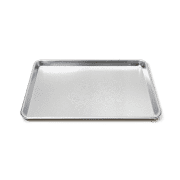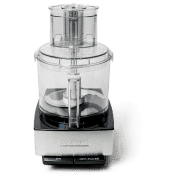
The Italian pumpkin zucca is plentiful in Emilia–Romagna, and when combined with the region's Parmigiano Reggiano it serves as a luscious, rich filling for cappellacci di zucca, a beloved, signature dish of the city of Ferrara. We found that butternut squash is the best stateside substitute for the sweet-fleshed zucca. Variations of the filling often incorporate mostarda (a fruit and mustard condiment) or crumbled amaretti cookies. To streamline the grocery list, we omitted these additions, but we did like the brightness that the assertive, acidic mostarda contributed. A simple drizzle of high-quality balsamic vinegar, an esteemed product of the region, brought a similar balance to the dish. Because the cappellacci were relatively large, the seams and folds where the dough is pinched together remained chewy and undercooked in early tests. To fix this, we rolled the pasta until it was paper thin (translucent enough to see your hand through the dough). This way, even at its bulkiest folded parts, the pasta cooked up tender and supple in a matter of minutes. All these pasta pillows needed for sauce was a toss in melted sage butter. Read Less
Ingredients
Filling
- 1½ pounds butternut squash, peeled, seeded, and cut into 1-inch pieces (3½ cups)
- 6 tablespoons unsalted butter
- 2½ ounces Parmigiano-Reggiano cheese, grated (1¼ cups)
- Salt and pepper
- Pinch ground nutmeg
Cappellacci
- 6 tablespoons unsalted butter
- 1 tablespoon minced fresh sage
- 1 recipe Fresh Egg Pasta
- Salt
- Balsamic vinegar
- Shaved Parmigiano-Reggiano cheese
Equipment

Rimmed Baking Sheets

Food Processor
Before You Begin
Do not use frozen squash here. Our favorite pasta machine is the Marcato Atlas 150 Wellness Pasta Machine; the pasta will be thin and semi-transparent when rolled to setting 8.
Instructions
- For the filling: Microwave squash in covered bowl until very soft and easily pierced with fork, 15 to 18 minutes, stirring halfway through microwaving. Carefully remove cover, allowing steam to escape away from you, and drain squash.
- Process squash, butter, Parmigiano, ¼ teaspoon salt, ⅛ teaspoon pepper, and nutmeg in food processor until smooth, about 1 minute, scraping down sides of bowl as needed. Transfer filling to bowl and refrigerate for 30 minutes. (Filling can be refrigerated for up to 24 hours.)
- For the cappellacci: Transfer dough to clean counter, divide into 6 pieces, and cover with plastic wrap. Flatten 1 piece of dough into ½-inch-thick disk. Using pasta machine with rollers set to widest position, feed dough through rollers twice. Bring tapered ends of dough toward middle and press to seal. Feed dough seam side first through rollers again. Repeat feeding dough tapered ends first through rollers set at widest position, without folding, until dough is smooth and barely tacky. (If dough sticks to fingers or rollers, lightly dust with flour and roll again.)
- Narrow rollers to next setting and feed dough through rollers twice. Continue to progressively narrow rollers, feeding dough through each setting twice, until dough is paper thin, transparent, and delicate. (Pasta sheet should be about 5 inches wide; if not, fold sheet in half crosswise and roll again.) Transfer sheet of pasta to liberally floured sheet of parchment paper. Cover with second sheet of parchment, followed by damp kitchen towel, to keep pasta from drying out. Repeat rolling with remaining 5 pieces of dough, stacking pasta sheets between floured layers of parchment.
- Liberally dust rimmed baking sheet with flour. Using pizza cutter or sharp knife, cut 1 pasta sheet into 5-inch squares on lightly floured counter (keep remaining sheets covered); discard scraps. Place 1 rounded tablespoon filling in center of each square. Working with 1 pasta square at a time, lightly brush edges with water. With one corner of pasta square facing you, fold bottom corner of pasta over filling until flush with top corner to form triangle shape. Press to seal edges flush to filling. Trim any uneven edges.
- With folded edge of filled pasta facing you, pull corners together below filling until slightly overlapped to create cappellacci with cupped outer edge and dimpled center. Press to seal overlapping edges and transfer to prepared sheet. Repeat cutting and filling remaining pasta (you should have about 18 cappellacci). Let cappellacci sit uncovered until dry to touch and slightly stiffened, about 30 minutes. (Cappellacci can be wrapped with plastic and refrigerated for up to 4 hours or chilled in freezer until firm, then transferred to zipper-lock bag and frozen for up to 1 month. If frozen, do not thaw before cooking; increase simmering time to 6 to 8 minutes.)
- Melt butter in 12-inch skillet over medium heat. Off heat, stir in sage and ¼ teaspoon salt; set aside. Bring 4 quarts water to boil in large pot. Add half of cappellacci and 1 tablespoon salt and simmer gently, stirring often, until edges of cappellacci are al dente, 4 to 6 minutes. Using slotted spoon, transfer cappellacci to skillet, gently toss to coat, and cover to keep warm. Return cooking water to boil and repeat cooking remaining cappellacci; transfer to skillet and gently toss to coat. Drizzle individual portions with balsamic vinegar and top with Parmigiano before serving.
Copyright © 2025 NetChain Communications, Inc.
All Rights Reserved.